Isenberg Summit Focuses on Inclusivity
November 1, 2019
“Are you taking the time to have real conversations with people from other places—getting to know them for real?” asked Ken Bouyer, EY Americas Inclusiveness Recruiting Leader, in his keynote address at Isenberg’s inaugural Inclusive Leadership Summit on October 19. Likening surface conversations to the tip of an iceberg, he advised: “Get below the water line. That is what inclusive leadership is about.”
Most of the event’s 350 participants were students—primarily from business and STEM disciplines—who attended to learn about the vital nature of the diversity and inclusion work at American companies. Industry representatives (including many Isenberg alumni) and educators helmed panels and workshops that gave attendees insight into how companies are ensuring that their workforces both include employees from a wide range of backgrounds (including race, ethnicity, gender, sexual orientation, disability status, and socioeconomic background) and also make full use of the talents and perspectives those workers bring.
“Diversity is about getting invited to the dance. Inclusiveness is about getting up and dancing,” Bouyer said during his address, paraphrasing diversity consultant Vernā Myers (who currently serves as VP of inclusion strategy for Netflix). “If you don’t appreciate and respect differences, you will not do well at our firm,” said Bouyer, whose employer partnered with Isenberg to host the summit. “We have dialogue, conversations with employees we don’t agree with.” Coworkers from different cultures view problems from different perspectives, and their insights enhance teamwork and make the business stronger, he insisted.
Topics covered on the summit’s program included challenges faced by young alumni, changing perceptions of leadership, unconscious biases, LGBTQ issues, implications of technology, and disability challenges. In addition, a plenary panel over lunch explored present and future interfaces between diversity and inclusion and automation, machine learning, algorithmic decisions, and other technologies. Student participants also competed in a case competition.*
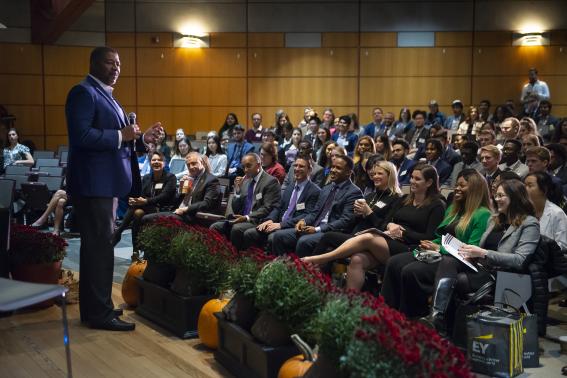
In a coda to his keynote talk, Bouyer shared the stage in a conversation with Kenneth Polite, a partner in the law firm, Morgan, Lewis & Bockus. Polite was U.S. Attorney for the Eastern District of Louisiana from 2013 to 2017. “My boss was Eric Holder; his boss was Barack Obama,” Polite told the gathering. Polite grew up in New Orleans, but his next stop, Harvard University, proved bittersweet. He roomed and spent free time with black students. Apart from African American studies courses with high-profile educators like Cornell West and Spike Lee, his classes were uniformly white. “In hindsight, there was a lack of inclusive leadership,” he recalled. Law school at Georgetown was vastly different,” he continued. There were black deans and the students understood and appreciated cultural differences and socioeconomic issues.
“I was blessed with fantastic mentors,” he noted. “My strongest ones [at Georgetown and as a judicial clerk] were white males. We all need allies.” Under Eric Holder, “I was the youngest U.S. Attorney in the whole country.” he continued. Polite concluded the conversation with advice for the students. “Get out of this campus and reach out to the community.”
Young Alumni Perspectives and Advice
“During my first year at work, I withheld personal information from others. I wouldn’t bring my authentic self to work,” recalled Fadjanie Cadet ’14, a manager on the Talent Operations Projects and Programs team at the e-commerce furniture and home goods company, Wayfair. Cadet was one of four panelists in a session devoted to D&I challenges and perspectives shared by young alumni. “In time, I discovered that people really wanted to know who I was,” she continued. The upshot: “I feel much better at work and I do better." Acknowledging and celebrating differences, she said, create a more productive workplace.
Dell Technologies Senior Finance Analyst Ellen McDonald ’16 concurred. Learning more about where others are coming from and where they came from can only improve productivity, she remarked. Studies, she noted, have proved that point. Differences, she added, include economic as well as cultural backgrounds. “I grew up on the Cape; there were three to six black people in my high school. Some affluent coworkers assumed that it was my family’s summer home, added McDonald, who is white. “It was our only home.”
What makes you different adds value to the experiences of your coworkers and your firm, observed Ta-Von Wilson ‘14, a manager with EY. That includes generational distinctions. “Some people here [at EY] are finally younger than me. I am learning how to talk to them.” Understanding differences, of course, includes cultural and economic perspectives. “Take a section of those you’ve texted at the conference today,” he told the students. “If they all look like you, find someone different at this summit.”
Women are also important in the D&I equation, noted Carolyn Warger ’09, a senior manager with Grant Thornton. “As a student I asked, “What do I need to do to bring more women back to campus?” When Warger joined the workforce, 95 percent of her firm’s partners were white. “I have seen growth and progress,” she emphasized.
“Progress must be intentional; not by accident,” added Cadet. The other panelists also offered advice. “Set some goals for yourself and continue to reassess them,” Wilson recommended. “Ask yourself: How do I get to that point.” “Sit with people who are different. Celebrate those differences,” McDonald advised. “Do all you can,” added Warger. “Your generation will push the narrative.”
Senior Executives Weigh In
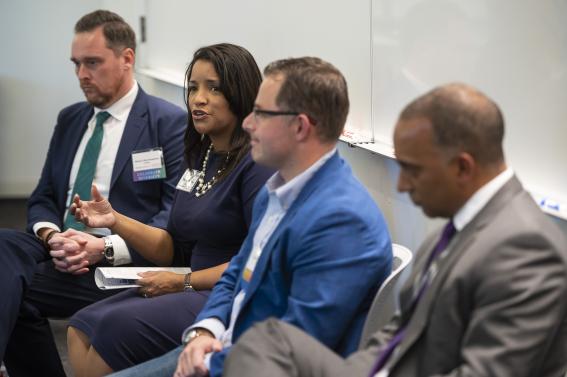
We must bring our employees’ cultural competencies up to speed, advised William Bradshaw, National Manager on KPMG’s Inclusion and Diversity team. To that end, Bradshaw’s many recommendations included a day of dialogue, where employees unpack cultural differences and their implications. “Studies show that the process to improve D&I is hard, but that it pays off,” observed Tracey Walker, VP and National Director of Government Affairs at RSM. “Inclusive leadership,” she said, “is a skill that is closer to innovation.” “The cost of blown retention itself should convince management that D&I programs pay off,” added Tony Jordan ’96, a partner and Americas Forensics Leader with EY. “We employ unconscious bias training, diversity partnerships, and [relevant] data audits, noted PwC Assurance Partner David Swerling ’04 ’05 MSA. Firms, though, should avoid rushing into programs based on metrics, he cautioned.
How do you determine whether investments in D&I are necessary, how do you make good on them, and how do you measure results? asked Johnson. A survey that identifies a firm’s underrepresented populations is a good place to started, Walker advised. “Also, you should do data analytics to determine who gets promoted to the leadership team.” Your survey, added Bradshaw, should assess strengths and weaknesses. It should also determine whether the firm is holding leaders accountable and whether there is a sense of belonging in the organization. “If you don’t push D&I down the organization, it’s not going to work,” added Jordan. “[Employee] confidence is also extremely important. You will never be successful without it.”
Why is D&I good for business? asked Johnson. “It helps us penetrate and expand global markets,” observed Bradshaw. It contributes to a diversity of ideas, added Swerling. That and diversity at the top he said, help drive profitability. So do trust and a sense of belonging, emphasized Walker. Both connect to the bottom line.
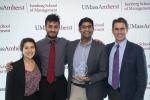
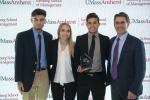
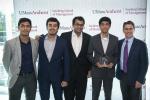
The second-place team (middle photo) comprised all Isenberg students: Igor De Sousa-Vieira (OIM), Sophia Alfano (marketing), Dalton Bere (finance), and Jacqueline Wright (marketing).
The case competition's winning graduate team (photo at right) comprised Harshad Kulkarni, Arjun Mohan, Husain Tawawala, and Aashish Yadav (all engineering).
Both teams are pictured with Jason Janoff '93, a partner at event sponsor EY.









